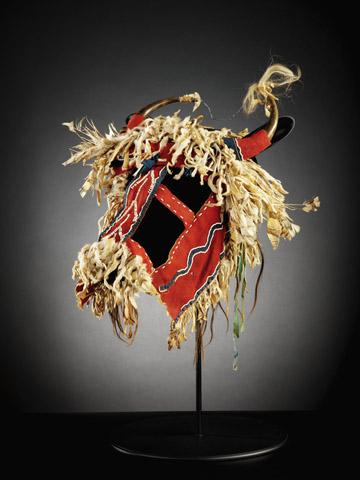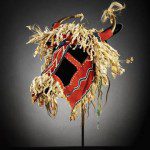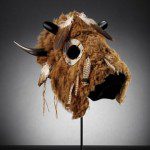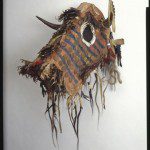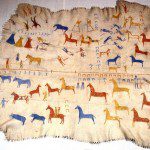In the pictorial lexicon of American history, there is perhaps no image more potent and quixotic than the archetype of the Native American on horseback. From Walt Disney to J.M. Barry, the lure of the American Indian’s intimacy with these deeply spiritual and powerful creatures has inspired imaginations for generations.
But horses as we know them today didn’t get to the Western hemisphere until Columbus brought a herd of 25 over on his second voyage to the new world in 1493. From this first handful of animals, the lives of Native Americans changed forever. From the way they traveled and hunted, to their celebration rituals and ceremonies, to new artistic expressions and traditions that continue to this day, horses quickly became an indispensable component of Native American life. In their newest exhibit, “A Song for the Horse Nation,” the National Museum of the American Indian takes us deep into the bond between our native citizens and the Horse Nation.
Walking through the exhibition, there are more words and artifacts than you can wrap your head around. But even as you process the first pieces of information, something makes itself clear very quickly: as a culture, American Indians are abundantly thoughtful people. Most of the artifacts and artworks on display in the exhibition have very utilitarian functions, from saddles to headstalls for horses, to basic clothing and housing. And yet everything is executed with a fine and personal sense of style, beauty and aesthetic that recalls some of the great artistic movements of the Common Era. You see the vibrant, earthy color palette of the impressionists, the sophisticated, stylized flatness of the Byzantines and the hieroglyphic narrative of the ancient Egyptians.
Native American culture is well known for its distinct visual language, which seems to have naturally enveloped the Horse Nation upon its introduction into their society. They became expert in fabricating horse gear for hunt and for war while transforming this equipment into a unique level of art.
Some of the most beautiful displays are of the horse masks, used in wartime and in peace to adorn the animals. Made of materials such as owl feathers, hide, buffalo horn, porcupine quills, brass tacks, ermine and even sinew, these masks are haunting and dreamlike, and you can imagine how utterly transformative these head coverings would be if, say, it was charging toward you in battle or part of a ritual dance ceremony.
But perhaps the most significant way that horses transformed Native American life was in their ability to hunt. Before horses, buffalo hunting on the Great Plains was a risky, exhausting and arduous job. Hunters had to track them on foot, and the process involved many men and took days of planning. But on horseback, a lone hunter could bring down a buffalo by himself and with relative efficiency. Furthermore, since tribes could travel farther, access to resources was expanded and people were better fed. As such, they acquired more time for art, spirituality and philosophy.
As their lifestyles now permitted more time for temporal liberties, Native Americans forged unbreakable bonds with the Horse Nation. Plains tribes embraced the horse as a brother in spirit and a link to the supernatural realm, embodying it with beauty, energy and healing powers in ceremonial objects representing these connections. Dance sticks on display in the exhibition were once carried by warriors in ceremonial dances, decorated symbolically with such flourishes as brass bells and eagle feathers.
With the arrival of horses, new ideas in design and ornament circulated through Native trade routes from Mexico to the Pacific Northwest. And while some things were acquired through trading with the Spanish, Native craftsmen largely made their own devices. From saddles, bridles and cinches, to whips and ropes, each tool, as seen in this exhibit, took on a remarkable level of craft and spirituality. Blending a variety of international influences—Spanish saddles, eastern beadwork, traditions of family and tribal identity—Native artists created a rich new visual art form.
The status of women also improved as a result of the Horse Nation. Horses helped lighten the workload, and women gained more time for creating art and enriching their society. Women’s arts, such as beadwork and ornamenting hides with porcupine quills, flourished.
The issue of Native identity continues to resonate today, as Native people across the country seek to claim the future on their own terms. Ushering in Native American heritage month this November, “A Song for the Horse Nation” shines a light on the soul of the American Indian’s national community and invites us in to experience it ourselves. It is difficult to encapsulate everything within this exhibition, but as a whole, it resonates with the strength and beauty of a stallion.
“A Song for the Horse Nation” is on view at the National Museum of the American Indian through Jan. 2, 2013. For more information visit the museum’s website: NMAI.si.edu.

